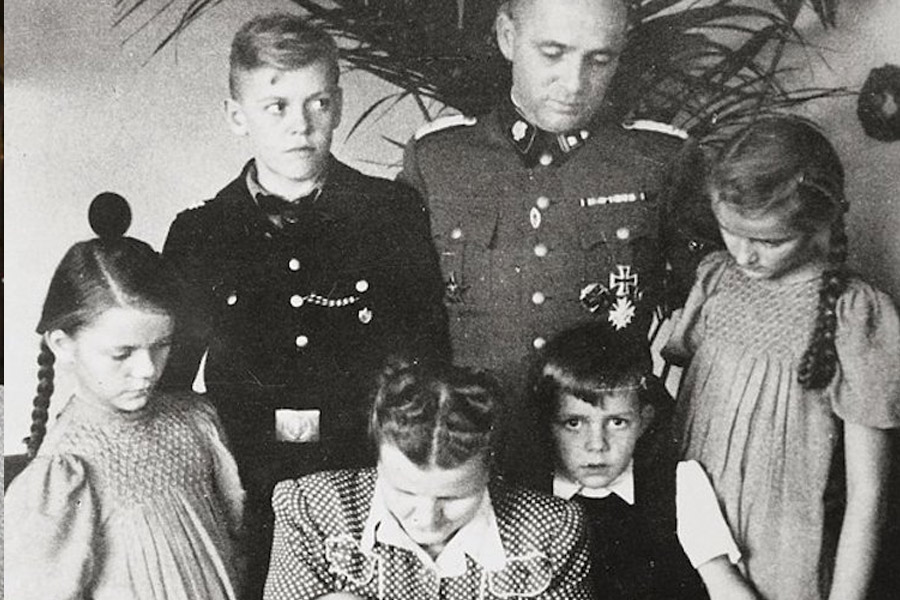Basic Information
| Field | Details |
|---|---|
| Name | Hedwig Hensel |
| Also associated with | Spouse of Rudolf Hoss |
| Born / Died | 1908 – 1989 |
| Marriage date | 17 August 1929 |
| Children | Five (Klaus, Heidetraud, Inge-Brigitte / Brigitte, Hans-Jürgen, Annegret) |
| Noted residence | The family villa beside Auschwitz (while Rudolf Hoss was commandant) |
| Public role / occupation | No public career recorded — described in records as wife and mother, household head |
| Net worth | No reliable public estimate available |
A Quiet Biography, a Loud Context
I like to think of biographies as film treatments: a few crisp scenes that, strung together, tell the story. For Hedwig Hensel the frame is unsettlingly cinematic — a tidy domestic interior, children’s shoes by a doorway, and beyond the window a landscape that would become the center of some of the twentieth century’s worst crimes. Hedwig was born in 1908, married on 17 August 1929, and over the next decades became the mother of five. The facts are simple; the atmosphere is anything but.
She married Rudolf Hoss in 1929, and throughout the 1930s and into the war years she is presented in surviving records and interviews primarily as a homemaker — the woman who kept the household running, who raised the children, and who lived in the villa that, for a time, sat uncomfortably close to a machine of mass murder. That contrast — the ordinary cadence of family life against the extraordinary horror outside — is the unpredictable force that makes Hedwig’s life a subject for historians, journalists, and artists alike.
Family Portrait: Names, Years, Introductions
Family life defines the archival trace Hedwig leaves. Below I present the family as people — not myth, not shorthand — each with a small introduction.
| Name | Born (year) | Relationship | Short introduction |
|---|---|---|---|
| Rudolf Hoss | — | Husband | The commandant whose postings shaped the family’s moves; the public face that determined private fate. |
| Klaus Hoss | 1930 | Son (eldest) | The firstborn, part of the household rhythms in the 1930s and later life abroad. |
| Heidetraud Hoss | 1932 | Daughter | One of the older daughters who grew up within the villa’s paradox. |
| Inge-Brigitte (Brigitte) Hoss | 1933 (d. Oct 2023) | Daughter | The daughter who later spoke about childhood memories and the family’s conflicted legacy. |
| Hans-Jürgen Hoss | 1937 | Son | A middle child present during the family’s wartime years. |
| Annegret Hoss | Nov 1943 | Daughter (youngest) | Born toward the end of the war; the youngest face of a family living amid extreme historical forces. |
Those names read like a cast list in a dark domestic drama: siblings, a mother who tended to schoolbooks and meals, and a husband whose station shaped the family’s geography and the moral questions that follow any account of their lives.
Numbers and Dates That Shape a Life
- 1908 — Hedwig Hensel is born.
- 17 August 1929 — Marriage to Rudolf Hoss.
- 1930–1943 — Five children are born across this time span (1930, 1932, 1933, 1937, 1943).
- 1989 — Hedwig’s death.
- Count of children living in villa during commandant years: Five.
- Public career entries found: Zero — she is consistently presented as having no separate public profession.
These are the scaffolding numbers. They do not explain motives, emotional life, or the moral calculus of people who lived within and beside atrocity; they only pin down the life’s visible coordinates.
The Domestic Frame and Its Disquiet
If you’d asked me to describe the “typical” scene — Hedwig bringing tea, a child finishing homework, sunlight on a table — I would, because such banalities are repeatedly described in family recollections. But those scenes land like a cinematic cut: domestic warmth followed by the hard cut to the outside world’s shadow. Hedwig’s role, as recorded, was not that of a public actor; she was the engine of a private routine: meals, children, visitors, household accounts. That ordinariness is exactly what has made the family story so gripping in recent retellings — the uncanny juxtaposition of the everyday with the utterly unthinkable.
There is also the difficult conversation about knowledge and responsibility. Family interviews and recollections, spoken decades after the events, trace a complicated human terrain: denial, awareness, helplessness, grief. I’m careful with language here: to be “housewife” is not an explanation for the world beyond a window, but it is the role the archives and testimonies consistently assign to Hedwig.
Public Life, Reputation, and Money
There’s a simple, slightly blunt fact to note: there is no reliable public record of Hedwig Hensel’s net worth, nor of a separate professional career. Her public footprint is primarily relational — spouse, mother, resident of a villa that later became a subject of historical scrutiny. Where money and property arose in records, it was typically in relation to the household, estate maintenance, or restitution debates decades later; there are no clear, reputable figures to attach to “net worth.”
Contemporary Resonance: Why People Again Ask Her Name
In recent years (and in contemporary culture), the family’s private life became a prism through which writers and filmmakers interrogate how humanity can coexist with atrocity. That renewed interest — a film here, a museum exhibit there — is not about vindication; it’s about the discomfort of ordinary life nested beside systematic evil. Hedwig Hensel’s name circulates because the family’s story helps us test narratives we prefer to keep neat: innocence, guilt, ignorance, complicity. The answers remain messy.
FAQ
Who was Hedwig Hensel?
Hedwig Hensel was born in 1908 and is primarily known as the wife of Rudolf Hoss, with whom she had five children and who lived in the villa adjacent to Auschwitz during his commandant years.
How many children did she have?
She had five children: Klaus (b.1930), Heidetraud (b.1932), Inge-Brigitte/Brigitte (b.1933), Hans-Jürgen (b.1937), and Annegret (b.1943).
Did Hedwig Hensel have a public career?
No; available records and interviews describe her in the role of wife and mother, and there is no documented public career.
When did she marry Rudolf Hoss?
She married Rudolf Hoss on 17 August 1929.
Is there a known net worth for Hedwig Hensel?
No reliable public estimate of Hedwig Hensel’s net worth is available in standard biographical records.
Why has the family received renewed attention in recent years?
The family’s life — domestic details set against the backdrop of historical atrocities — has been revisited in contemporary culture and media, prompting renewed public interest and debate.



